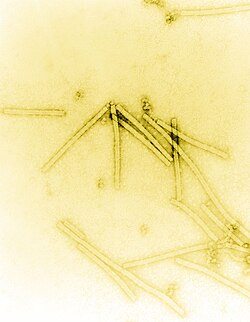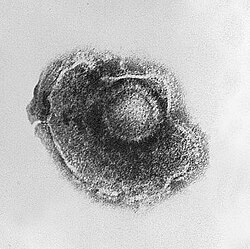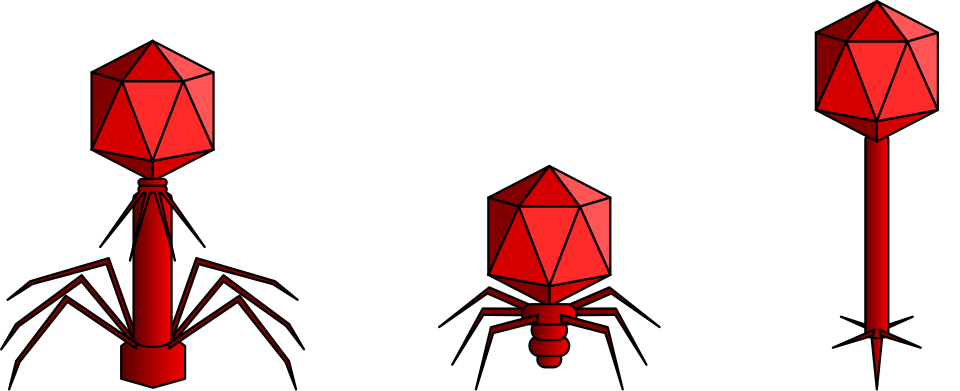Difference between revisions of "AY Honors/Viruses/Answer Key"
JadeDragon (talk | contribs) m (wikilink fix) |
JadeDragon (talk | contribs) (add photos and 4 types with examples) |
||
| Line 50: | Line 50: | ||
===c. Name some morphological shapes of viruses and give an example of each.=== <!--T:51--> | ===c. Name some morphological shapes of viruses and give an example of each.=== <!--T:51--> | ||
| − | The shapes of virus particles range from simple helical and icosahedral forms for some virus species to more complex structures for others. | + | The shapes of virus particles range from simple helical and icosahedral forms for some virus species to more complex structures for others. |
| + | |||
| + | Viruses come in many shapes and sizes, but these are consistent and distinct for each viral family. In general, the shapes of viruses are classified into four groups: | ||
| + | |||
| + | '''Filamentous''' viruses are long and cylindrical. Many plant viruses are filamentous, including the''TMV (tobacco mosaic virus)'' which was the first virus identified. | ||
| + | [[File:TobaccoMosaicVirus.jpg|200px]] | ||
| + | |||
| + | '''Isometric''' viruses have shapes that are roughly spherical. Examples include poliovirus and herpesviruses. | ||
| + | [[File:Polio.jpg|200px]] | ||
| + | |||
| + | '''Enveloped''' A virus that has an outer wrapping or envelope. This envelope comes from the infected cell, or host, in a process called "budding off." During the budding process, newly formed virus particles become "enveloped" or wrapped in an outer coat that is made from a small piece of the cell's plasma membrane. The envelope may play a role in helping a virus survive and infect other cells. Animal viruses, such as HIV (caused AIDS), are frequently enveloped. | ||
| + | |||
| + | [[File:Varicella_(Chickenpox)_Virus_PHIL_1878_lores.jpg|200px]] | ||
| + | Chickenpox virus which is enveloped. | ||
| + | |||
| + | '''Head and tail''' viruses infect bacteria. They have a head that is similar to icosahedral viruses and a tail shape like filamentous viruses. Here are the three families based on like shape and other characteristics: | ||
| + | [[File:Caudovirales.svg]] | ||
| + | From left to right: Myoviridae, Podoviridae, and Siphoviridae | ||
| + | |||
| + | Many viruses use some sort of glycoprotein to attach to their host cells via molecules on the cell called viral receptors. For these viruses, attachment is a requirement for later penetration of the cell membrane, allowing them to complete their replication inside the cell. The receptors that viruses use are molecules that are normally found on cell surfaces and have their own physiological functions. Viruses make use of these molecules for their own replication. <ref>Source: Boundless. “Viral Morphology.” Boundless Biology. Boundless, 21 Jul. 2015. Retrieved 14 Oct. 2015 from https://www.boundless.com/biology/textbooks/boundless-biology-textbook/viruses-21/viral-evolution-morphology-and-classification-136/viral-morphology-550-11760/</ref> | ||
===d. Explain the importance of vaccines to combat viruses. How do they work?=== <!--T:52--> | ===d. Explain the importance of vaccines to combat viruses. How do they work?=== <!--T:52--> | ||
Revision as of 23:07, 14 October 2015
Template:Honor desc
Template:Honor Master
1. Describe or discuss the following with a group. If necessary research possible answers to these topics so that you can make meaningful contributions to the group.
The Pathfinder is encouraged to independently research online or in a high school biology textbook to get an understanding of viruses, their characteristics and effects. Independent reading gives the Pathfinder the opportunity to dig deeper and explore areas of interest that will help them complete the practical Requirements #3 and #6 of this honor.
We provide introductory information to assist in teaching the honor.
a. What does the word virus mean? Explain the controversy regarding whether it is alive or not.
A virus is a small infectious agent that replicates only inside the living cells of other organisms. Viruses can infect all types of life forms, from animals and plants to microorganisms, including bacteria and archaea. The study of viruses is known as virology, a subspecialty of microbiology.
Dmitri Ivanovsky, a Russian botanist, was the first person to discover viruses (1892) and thus one of the founders of virology. He identified a non-bacterial pathogen infecting tobacco plants, which was named the tobacco mosaic virus by Martinus Beijerinck in 1898.
About 5,000 virus species have been described in detail, although there are millions of different types. Viruses are found in almost every ecosystem on Earth and are the most abundant type of biological entity.
Viruses are considered by some to be a life form, because they carry genetic material, reproduce, and evolve through natural selection. However they lack key characteristics (such as cell structure) that are generally considered necessary to count as life. Because they possess some but not all such qualities, viruses have been described as "organisms at the edge of life".
b. Name the distinctive characteristics of viruses and why they're not included in any kingdom.
While not inside an infected cell or in the process of infecting a cell, viruses exist in the form of independent particles known as virions that are inert and lifeless as a rock.
Since they are not alive and do not have cells, they are not classified into any of the five life kingdoms of Protista, Fungi, Plantae (plants), Animalia, and Monera (includes Eubacteria and Archeobacteria).
Instead, Virions consist of two or three parts:
(i) the genetic material made from either DNA or RNA, long molecules that carry genetic information;
(ii) a protein coat, called the capsid, which surrounds and protects the genetic material; and
(iii) in some cases an envelope of lipids that surrounds the protein coat when they are outside a cell.
Most virus species have virions that are too small to be seen with an optical microscope. The average virion is about one one-hundredth the size of the average bacterium.
Viruses are an important means of horizontal gene transfer, which increases genetic diversity.
c. Name some morphological shapes of viruses and give an example of each.
The shapes of virus particles range from simple helical and icosahedral forms for some virus species to more complex structures for others.
Viruses come in many shapes and sizes, but these are consistent and distinct for each viral family. In general, the shapes of viruses are classified into four groups:
Filamentous viruses are long and cylindrical. Many plant viruses are filamentous, including theTMV (tobacco mosaic virus) which was the first virus identified.

Isometric viruses have shapes that are roughly spherical. Examples include poliovirus and herpesviruses.

Enveloped A virus that has an outer wrapping or envelope. This envelope comes from the infected cell, or host, in a process called "budding off." During the budding process, newly formed virus particles become "enveloped" or wrapped in an outer coat that is made from a small piece of the cell's plasma membrane. The envelope may play a role in helping a virus survive and infect other cells. Animal viruses, such as HIV (caused AIDS), are frequently enveloped.
 Chickenpox virus which is enveloped.
Chickenpox virus which is enveloped.
Head and tail viruses infect bacteria. They have a head that is similar to icosahedral viruses and a tail shape like filamentous viruses. Here are the three families based on like shape and other characteristics:
 From left to right: Myoviridae, Podoviridae, and Siphoviridae
From left to right: Myoviridae, Podoviridae, and Siphoviridae
Many viruses use some sort of glycoprotein to attach to their host cells via molecules on the cell called viral receptors. For these viruses, attachment is a requirement for later penetration of the cell membrane, allowing them to complete their replication inside the cell. The receptors that viruses use are molecules that are normally found on cell surfaces and have their own physiological functions. Viruses make use of these molecules for their own replication. &
d. Explain the importance of vaccines to combat viruses. How do they work?
e. Describe how viruses reproduce and how the genetic modifications called mutations occur and viral resistance.
f. Have viral diseases ever been eradicated? Why is it difficult to treat patients with viral diseases?
2. Through pictures, video, or detailed descriptions, explain the difference in the following exanthematous or rash diseases:
a. Rubella
b. Measles
c. Chickenpox
3. Choose three of the following viral diseases and describe their form of infection, symptoms and prevention. Demonstrate your learning creatively through a display, presentation, or prepared speech:
a. Cholera
b. Herpes
c. AIDS
d. Mumps
e. Poliomyelitis
f. Meningitis
g. Hepatitis
h. Dengue
4. Explain the difference between a cold and the flu. Why does the influenza virus cause periodic epidemics (like the Spanish flu, avian flu, H1N1, etc.)?
5. What is the difference between a virus and a prion? Name a disease caused by a prion.
6. Do one of the following:
a. Give a brief report about a viral pandemic and the impact it had / is having on the world.
b. Create a skit, multimedia presentation, or other interactive display that informs a 3rd world audience to the danger of one or more of these viruses and gives them training in how to combat or control the virus.
c. Have an Aid/relief worker give a talk or presentation about epidemics and virus control in third-world countries. Raise money as a group to support aid relief in the country/(ies) the worker tells you about.
References
- ↑ Source: Boundless. “Viral Morphology.” Boundless Biology. Boundless, 21 Jul. 2015. Retrieved 14 Oct. 2015 from https://www.boundless.com/biology/textbooks/boundless-biology-textbook/viruses-21/viral-evolution-morphology-and-classification-136/viral-morphology-550-11760/
